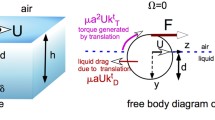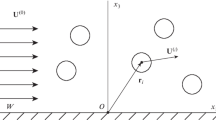Abstract
An analytical and numerical study for the creeping flow caused by a solid spherical particle with a slip-flow surface is considered in the presence of a fluid–fluid plane interface. The particle rotating about or translating along an axis perpendicular to the interface. The motion is investigated in the limit of low capillary number where in this situation the interface is of negligible deformation. Using a bipolar coordinate system, the stream functions are constructed for both fluid phases as Reynolds number tends to zero. The novelty of this work is allowing the slip on the surface of the particle. The matching boundary conditions at the plane interface and the slip boundary condition on the particle’s surface are applied to the truncated solutions to specify the unknown coefficients. A comparison is made between the results of the analytical solution and the results obtained from a boundary collocation method. The torque and drag force exerted on the particle are calculated using both techniques, which are found in perfect agreement. In addition to compression with collocation techniques, we also studied the predicted changes in the drag force and torque due to the presence of the plane interface and the slippage at the surface of the particle. Our results of the drag force and torque are compared with the available data in the literature for the special cases. The work is motivated by its possible application as an analytical tool in the study of locomotion of microswimmers near an interface such as synthetic swimmers and microorganisms.











Similar content being viewed by others
Abbreviations
- a :
-
Particle radius (m)
- \(A_{n} ,B_{n} ,C_{n} \) :
- \(a_{n} ,b_{n} ,c_{n} ,d_{n} ,a'_{n} ,c'_{n} \) :
- \(C_{1n} \left( \zeta \right) \) :
-
Function of \(\zeta \)defined by Eq. (A.5)
- \(C_{m} \) :
-
Dimensionless coefficient accounting for the frictional slip
- c :
-
Geometrical constant \(\left( =a\, \sinh \alpha \right) \), \(\left( m\right) \)
- D :
-
\(=d/d\eta \)
- \(\vec {e}_{\rho } ,\vec {e}_{\phi } ,\vec {e}_{z} \) :
-
Unit vectors in cylindrical system
- \(\vec {e}_{\eta } ,\vec {e}_{\xi } ,\vec {e}_{\phi }\) :
-
Unit vectors in bipolar system
- F :
-
Hydrodynamic drag force on the particle, \(\left( N\right) \)
- \(f_{n} \) :
-
Function defined by Eq. (A.4)
- \(G_{n} \) :
-
Gegenbauer polynomial of order n and degree \(-1/2\)
- \(h_{\eta } ,h_{\xi } ,h_{\phi } \) :
-
Metrical coefficients of the bipolar coordinates defined by Eq.(3.3), \(\left( m\right) \)
- \(h_{in} ,\, \, i=1,...,4\) :
-
Functions listed in Appendix (A.6 - A.9)
- I :
-
Unit dyadic
- \(K_{n}\) :
-
Knudsen number \(\left( =\ell /a\right) \)
- L :
-
Spacing parameter \(\left( =a/z_{0} \right) \)
- \(L_{-1} \) :
-
Stokes operator, \(\left( m^{-2} \right) \)
- M :
-
Number of equations in the band matrix
- N :
-
Number of collocation points on particle surface
- \(\vec {n}\) :
-
Outward normal unit vector
- \(n_{i} ,\, \,~~~ i=1,2,...,5\) :
-
Half integer numbers
- \(p,p'\) :
-
Pressure field below and above the interface, respectively, \(\left( N\, m^{-2} \right) \)
- \(P_{n}^{1} \) :
-
Associated Legendre function of the first kind
- \(\vec {q},\vec {q'}\) :
-
Fluid velocity field below and above the interface, respectively, \(\left( m\, s^{-1} \right) \)
- \(q_{\eta } ,q_{\xi } ,q_{\phi } \) :
-
Components of \(\vec {q}\) in spherical bipolar coordinates , \(\left( m\, s^{-1} \right) \)
- \(q'_{\eta } ,q'_{\xi } ,q'_{\phi } \) :
-
Components of \(\vec {q}'\) in spherical bipolar coordinates, \(\left( m\, s^{-1} \right) \)
- T :
-
Hydrodynamic torque acting on particle, \(\left( N\, m\right) \)
- U :
-
Migration velocity of the particle, \(\left( m\, s^{-1} \right) \)
- \(U_{n} ,V_{n} \) :
- w :
-
\(=\cosh \alpha -\zeta \)
- \(\psi ,\psi '\) :
-
Stokes stream function below and above the interface, respectively, \(\left( m^{3} s^{-1} \right) \)
- \(\alpha _{n} ,\beta _{n} ,\gamma _{n} \) :
-
coefficients defined by Eqs. (A.1–A.3)
- \(\beta \) :
-
reciprocal of the slip coefficient at the particle surface, \(\left( kg\, \, m^{-2} \, \, s^{-1} \right) \)
- \(\beta ^{*} =a\beta /\mu _{1} \) :
-
slip parameter
- \(\lambda =\mu _{2} /\mu _{1} \) :
-
viscosity ratio parameter
- \(\ell \) :
-
mean free path of fluid molecule, \(\left( m\right) \)
- \(\mu _{1} ,\mu _{2} \) :
-
dynamic viscosity below and above the interface, respectively, \(\left( kg\, \, m^{-1} \, \, s^{-1} \right) \)
- \(\prod _{\eta \phi } ,\prod '_{\eta \phi }\) :
-
tangential stresses defined by Eqs. (3.16) and (3.17), \(\left( N\, m^{-2} \right) \)
- \(\prod _{\eta \xi } ,\prod '_{\eta \xi }\) :
-
tangential stresses defined by Eqs. (4.6) and (4.7), \(\left( N\, m^{-2} \right) \)
- \(\Omega \) :
-
angular velocity of the particle, \(\left( s^{-1} \right) \)
- \(\left( \rho ,\phi ,z\right) \) :
-
cylindrical coordinates
- \(\left( \eta ,\xi ,\phi \right) \) :
-
spherical bipolar coordinates
- \(\alpha \) :
-
\(=\sinh ^{-1} \sqrt{L^{-2} -1}\)
- \(\zeta \) :
-
\(=\cos \xi \)
References
Eric Lauga, Thomas R. Powers, The hydrodynamics of swimming microorganisms. Rep. Prog. Phys. 72(9), 096601 (2009)
M.Cristina Marchetti, Jean-François Joanny, Sriram Ramaswamy, Tanniemola B. Liverpool, Jacques Prost, Madan Rao, R. Aditi Simha, Hydrodynamics of soft active matter. Rev. Mod. Phys. 85(3), 1143 (2013)
G.-J. Li, Alireza Karimi, Arezoo M. Ardekani, Effect of solid boundaries on swimming dynamics of microorganisms in a viscoelastic fluid. Rheol. Acta 53(12), 911–926 (2014)
Dario Papavassiliou, Gareth P. Alexander, Exact solutions for hydrodynamic interactions of two squirming spheres. J. Fluid Mech. 813, 618–646 (2017)
J. Bławzdziewicz, M.L. Ekiel-Jeżewska, E. Wajnryb, Motion of a spherical particle near a planar fluid-fluid interface: The effect of surface incompressibility. J. Chem. Phys. 133(11), 114702 (2010)
Henry von Wahl, Thomas Richter, Stefan Frei, Thomas Hagemeier, Falling balls in a viscous fluid with contact: Comparing numerical simulations with experimental data. (2020). arXiv preprint arXiv:2011.08691
W.R. Dean, M.E. O’Neill, A slow motion of viscous liquid caused by the rotation of a solid sphere. Mathematika 10(1), 13–24 (1963)
M.E. O’Neill, K. Stewartson, On the slow motion of a sphere parallel to a nearby plane wall. J. Fluid Mech. 27(4), 705–724 (1967)
Arthur Joseph Goldman, Raymond G. Cox, Howard Brenner, Slow viscous motion of a sphere parallel to a plane wall–I Motion through a quiescent fluid. Chem. Eng. Sci. 22(4), 637–651 (1967)
A.J. Goldman, R.G. Cox, H. Brenner, Slow viscous motion of a sphere parallel to a plane wall–II Couette flow. Chem. Eng. Sci. 22(4), 653–660 (1967)
S.H. Lee, R.S. Chadwick, L. Gary Leal, Motion of a sphere in the presence of a plane interface. Part 1. An approximate solution by generalization of the method of Lorentz. J. Fluid Mech. 93(4), 705–726 (1979)
S.H. Lee, L.G. Leal, Motion of a sphere in the presence of a plane interface. Part 2. An exact solution in bipolar co-ordinates. J. Fluid Mech. 98(1), 193–224 (1980)
M.E. O’Neill, B.S. Bhatt, Slow motion of a solid sphere in the presence of a naturally permeable surface. Quart. J. Mech. Appl. Math. 44(1), 91–104 (1991)
Sukalyan Bhattacharya, Jerzy Blawzdziewicz, Effect of small particles on the near-wall dynamics of a large particle in a highly bidisperse colloidal solution. J. Chem. Phys. 128(21), 214704 (2008)
John Happel, Howard Brenner, Low Reynolds number hydrodynamics: with special applications to particulate media, vol. 1 (Springer Science and Business Media, 2012)
Ernest Bart, The slow unsteady settling of a fluid sphere toward a flat fluid interface. Chem. Eng. Sci. 23(3), 193–210 (1968)
B.D. Goddard, R.D. Mills-Williams, J. Sun, The singular hydrodynamic interactions between two spheres in Stokes flow. Phys. Fluids 32(6), 062001 (2020)
Vaseem A. Shaik, Arezoo M. Ardekani, Motion of a model swimmer near a weakly deforming interface. J. Fluid Mech. 824, 42–73 (2017)
Stefano Villa, Giuseppe Boniello, Antonio Stocco, Maurizio Nobili, Motion of micro-and nano-particles interacting with a fluid interface. Adv. Colloid Interface Sci. 284, 102262 (2020)
Milford H. Davis, Collisions of small cloud droplets: Gas kinetic effects. J. Atmos. Sci. 29(5), 911–915 (1972)
S.K. Loyalka, Slip and jump coefficients for rarefied gas flows: variational results for Lennard-Jones and n (r)-6 potentials. Phys. A 163(3), 813–821 (1990)
G.K. Batchelor, An Introduction to Fluid Dynamics (Cambridge University Press, Cambridge, 1967)
E. Lauga, M.P. Brenner, Howard A. Stone, “Handbook of Experimental Fluid Dynamics.” Chap. Microfluidics: The No-Slip Boundary Condition (Springer, 2005)
O.I. Vinogradova, N.F. Bunkin, N.V. Churaev, O.A. Kiseleva, A.V. Lobeyev, B.W. Ninham, Submicrocavity structure of water between hydrophobic and hydrophilic walls as revealed by optical cavitation. J. Coll. Interface Sci. 173(2), 443–447 (1995)
J.Calvin Giddings, Displacement and dispersion of particles of finite size in flow channels with lateral forces. Field-flow fractionation and hydrodynamic chromatography. Sep. Sci. Technol. 13(3), 241–254 (1978)
Chiu-On Ng, How does wall slippage affect hydrodynamic dispersion? Microfluid. Nanofluid. 10(1), 47–57 (2011)
R. Pit, H. Hervet, L. Leger, Direct experimental evidence of slip in hexadecane: solid interfaces. Phys. Rev. Lett. 85(5), 980 (2000)
L.D. Reed, F.A. Morrison Jr., Particle interactions in viscous flow at small values of Knudsen number. J. Aerosol Sci. 5(2), 175–189 (1974)
Simon L. Goren, The hydrodynamic force resisting the approach of a sphere to a plane wall in slip flow. J. Colloid Interface Sci. 44(2), 356–360 (1973)
Shih H. Chen, Huan J. Keh, Axisymmetric motion of two spherical particles with slip surfaces. J. Coll. Interface Sci. 171(1), 63–72 (1995)
Haoxiang Luo, C. Pozrikidis, Effect of surface slip on Stokes flow past a spherical particle in infinite fluid and near a plane wall. J. Eng. Math. 62(1), 1–21 (2008)
H. Loussaief, L. Pasol, F. Feuillebois, Motion of a spherical particle in a viscous fluid along a slip wall. Q. J. Mech. Appl. Mech. 68(2), 115–144 (2015)
A. Vidal, L. Botto, Slip flow past a gas-liquid interface with embedded solid particles. J. Fluid Mech. 813, 152–174 (2017)
Margaret Stimson, George Barker Jeffery, The motion of two spheres in a viscous fluid. Proceedings of the Royal Society of London. Series A, Containing Papers of a Mathematical and Physical Character 111(757), 110–116 (1926)
Michael J. Gluckman, Robert Pfeffer, Sheldon Weinbaum, A new technique for treating multiparticle slow viscous flow: axisymmetric flow past spheres and spheroids. J. Fluid Mech. 50(4), 705–740 (1971)
Peter Ganatos, Sheldon Weinbaum, Robert Pfeffer, A strong interaction theory for the creeping motion of a sphere between plane parallel boundaries. Part 1. Perpendicular motion. J. Fluid Mech. 99(4), 739–753 (1980)
Y.C. Chang, H.J. Keh, Slow motion of a slip spherical particle perpendicular to two plane walls. J. Fluids Struct. 22(5), 647–661 (2006)
H.H. Sherif, M.S. Faltas, E.I. Saad, Slip at the surface of a sphere translating perpendicular to a plane wall in micropolar fluid. Zeitschrift für angewandte Mathematik und Physik 59(2), 293–312 (2008)
H.H. Sherief, M.S. Faltas, E.A. Ashmawy, Slow motion of a sphere moving normal to two infinite parallel plane walls in a micropolar fluid. Math. Comput. Modell. 53(1–2), 376–386 (2011)
Author information
Authors and Affiliations
Corresponding author
Ethics declarations
Conflict of interest
We have no conflict of interest to declare.
Appendix
Appendix
where \(g_{n} \) which appears in \(h_{3n} \) and \(h_{4n} \) is given by
Rights and permissions
About this article
Cite this article
Sherief, H.H., Faltas, M.S. & Ragab, K.E. Exact solution for the slow motion of a spherical particle in the presence of an interface with slip regime. Eur. Phys. J. Plus 136, 466 (2021). https://doi.org/10.1140/epjp/s13360-021-01428-6
Received:
Accepted:
Published:
DOI: https://doi.org/10.1140/epjp/s13360-021-01428-6




